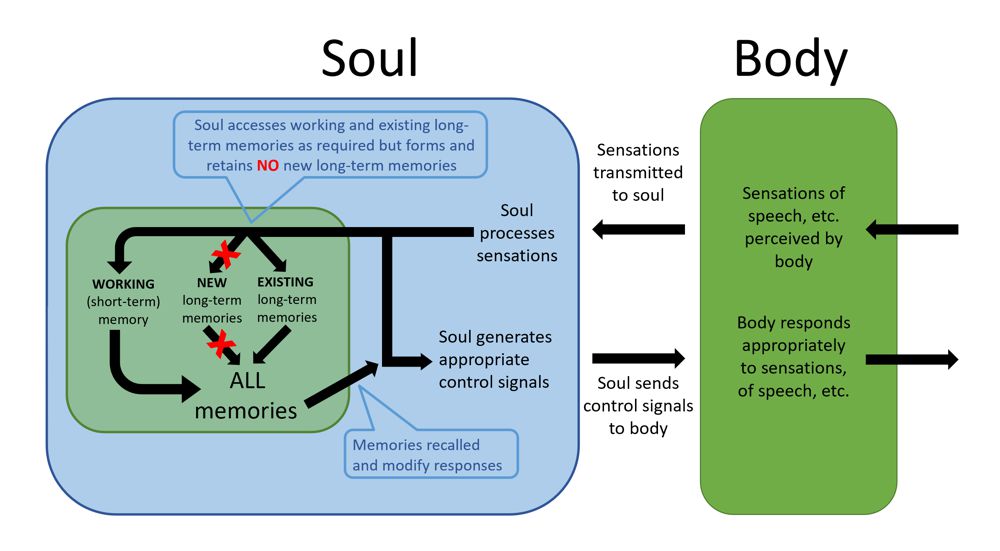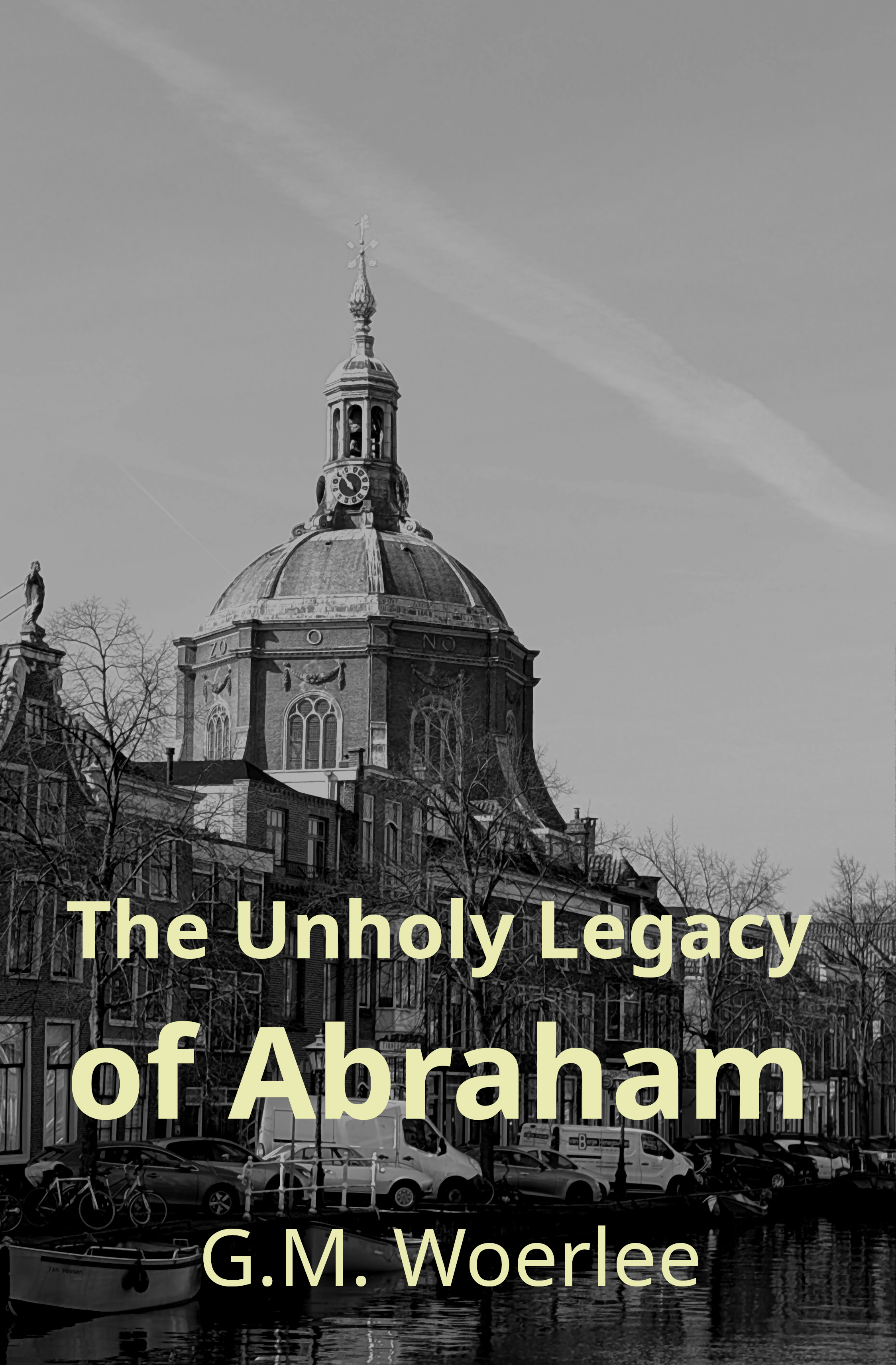No Memory means No Soul!
 Proof of the reality of a human soul, a separable human consciousness, (or whatever term favoured, but is classically known as the “soul”), with the properties as proposed by millennia of believers is required before proposing anything based upon this belief. Chapter 4 of the free ebook “Anesthesia & the Soul” is a step-by-step analysis of the reality of properties of the soul as propounded by popular belief systems and religions for the past 4,500 years (see the page “Belief in the Soul”). Some of these properties of the soul, or separable human consciousness, are amenable to testing in this physical world. The location of memory, whether in the soul or in the brain, is one such property as is explained in Chapter 5 of “Anesthesia & the Soul” (press download button below to read the ebook).
Proof of the reality of a human soul, a separable human consciousness, (or whatever term favoured, but is classically known as the “soul”), with the properties as proposed by millennia of believers is required before proposing anything based upon this belief. Chapter 4 of the free ebook “Anesthesia & the Soul” is a step-by-step analysis of the reality of properties of the soul as propounded by popular belief systems and religions for the past 4,500 years (see the page “Belief in the Soul”). Some of these properties of the soul, or separable human consciousness, are amenable to testing in this physical world. The location of memory, whether in the soul or in the brain, is one such property as is explained in Chapter 5 of “Anesthesia & the Soul” (press download button below to read the ebook).
Believers state that the human soul is the actual conscious mind of the body, controlling the body to speak and act, as well as being the indelible repository of all memories of the human body. All the apparent evidence for this system of thought is carefully analyzed in “Anesthesia & the Soul”, and is a worldwide belief system persisting unchanged for at least 4,500 years. Believers in the reality of a human soul claim the soul is the indelible repository of all memories. Proof for this belief is ostensibly revealed by religions stating that souls of the deceased retain all memories of their lives and thoughts while mortal, as well as reports of veridical observations made during out-of-body experiences undergone during cardiac arrest when there was no apparent brain activity, or memories reported by persons subsequent to near-death experiences many other causes. There are many more examples events ostensibly revealing the extracorporeal nature of memory. Chapter 4 of the free ebook “Anesthesia & the Soul” explains the properties of the separable human consciousness, or soul, revealing the relationship of memory and the soul as propoposed by believers in the soul.
Memory is an aspect of mental function very amenable to testing in this physical world. The memory effects of the drug “Midazolam” demonstrates memory to be a function of brain activity, and not an extracorporeal function of the human soul.How is this possible? Midazolam has been used to provide “conscious sedation” during medical procedures for more than twenty years and consistently blocks memory formation of events occurring during sedation. So what do physicians the world over observe during conscious sedation? (See extensive discussion in Chapter 7 of “Anesthesia & the Soul”)
- Midazolam administered at doses sufficient to cause amnesia does not induce loss of consciousness. After such doses of midazolam, most people are somewhat sedated, yet perceive and react appropriately to their surroundings. They are cooperative, talk normally, answer questions appropriately, can remember past events, and otherwise react appropriately with speech and movements.
- According to believers in the reality of the human soul, the physical body supposedly transmits perceptions of speech, sight, touch, and surroundings in some way to the soul, which then controls the body to speak, move, and act appropriately in response to others and the situation.
- The human soul is believed to be the indelible repository of all memories.
- The human soul is supposedly unaffected by drugs affecting the physical brain, which means that the memory functions of the human soul are also unaffected by midazolam.
- Therefore, according to believers in the reality of the human soul, the souls of persons undergoing conscious sedation with midazolam should form long-term memories of their thoughts, as well as their perceptions, speech, actions, and deeds while sedated.
- All physical brain functions return to normal after the body eliminates all the administered midazolam. But then something totally contrary to what the human soul mind-model propounds is observed — most people CANNOT REMEMBER remember any of their thoughts, speech, or actions during the period of conscious sedation.

During conscious sedation all physical sensations of movements, speech, vision are transmitted unchanged to the immaterial soul. The soul is unaffected by things affecting the physical brain, yet the drug midazolam blocks long-term memory formation and retention. This should be impossible if memory was a function of the soul, and therefore proves memory is not a function of the soul.
This observation is repeated many, many millions of times each year, all over the world wherever midazolam is employed for both its conscious sedation and amnesic effects. It is the daily reality and observation of all physicians and other personnel administering midazolam for conscious sedation.
Ostensible control of the body by the soul to speak, cooperate, and move, is unaffected by conscious sedation. The soul is unaffected by the drug midazolam, and so should also form memories of all events, speech, and movements occurring during conscious sedation. But this does not occur — memory formation is inhibited during conscious sedation, even though other functions are unaffected. The fact that memory formation is inhibited while other putative functions of the soul are unaffected, indicates that memory formation and retention are functions of the brain.
Upon hearing this, some believers in the reality of a human soul might exclaim, “Conscious sedation means that some regions of the physical brain are affected, otherwise no sedation would be present. This could possibly affect the signals transmitted from the body to the soul, and explain why the soul receives no signals indicating that it should retain memories of events and speech perceived during conscious sedation … ” Unfortunately such an explanation clearly implies that the brain is necessary to initiate memory formation and retention, meaning that the brain is necessary. Furthermore, such an explanation ignores the fact of general anesthesia without memories of events occurring during general anesthesia, or of absent memories of events occuring during cardiac arrest. Most people recovering from general anesthesia, and most cardiac arrest survivors have absolutely no memories of their periods of cardiac arrest, or general anesthesia. Yet in these latter situations their unfettered souls would have received no signals inhibiting memory formation and retention from their non-functioning brains, which is why most people should have vivid memories of all events occurring during general anesthesia after awakening from general anesthesia, and after surviving cardiac arrest. But most have no such memories — the rare memories of events occuring during general anesthesia are readily explained by awareness during general anesthesia, and in cardiac arrest surviviors, memories during these events are explained by retaining or retention of consciousness during these events. Chapter 10 in“Anesthesia & the Soul” explains how consciousness is possible during general anesthesia, while Chapter 12 explains how consciousness is possible during cardiac arrest (press download button below to read the ebook).
Only one conclusion is possible — memory formation and retention is a function of the brain and not of an imaterial soul. Absence of memory formation and retention by the soul has far-reaching implications as explained in Chapters 7 and 16 in “Anesthesia & the Soul”.
- A soul without the ability to form memories cannot recall what it experiences during periods of disembodiment. Accordingly, accounts of apparent disembodiment during out-of-body experiences are memories of perceptions made during hallucinations of disembodiment occurring within the physical brains of people subsequently reporting such experiences.
- The holy books of Christianity, Islam, Hinduism, Buddhism, etc, tell us that the souls of the dead remember their thoughts speech and deeds, and are appropriately punished or rewarded in a life after death, or undergo an appropriate reincarnation.
- Christianity and Islam propose a system of eternal punishment or reward in everlasting afterlife inhabited by the souls of the dead. However, absence of memory function in a separable immaterial conscious mind means that everlasting punishment or reward of the immaterial soul has no function. Without memory, punishment or reward are visited upon a conscious mind with no memories of anything. It would serve no real purpose—it would not even be punishment or reward—a soul without memory would just undergo these things without knowing or understanding. A soul without memory can experience no heaven, nor can it experience hell—heaven and hell simply do not exist for a soul without memory.
- Hinduism and Buddhism are two religions proposing reincarnation of the soul, but absence of memory in the soul means that the reincarnated soul learns nothing during each reincarnation. The reality of absent memory function in the human soul demolishes this fundamental postulate of reincarnation.
Absence of memory function in the soul means that an immaterial human soul with the properties propounded by believers for more than 4,500 years simply does not exist. Accordingly, the human soul, if it exists, has properties very different to those believed by most proponents of the reality of a human soul. This is all extensively discussed in the free ebook, “Anesthesia & the Soul”, which reveals how common observations in anesthesia and normal life reveal that memory is located withing the physical brain, and not within an immaterial soul, or separable human consciousness (press the download button below).
The reality of memory function and many other matters are discussed in the books “Anesthesia & the Soul” and “The Unholy Legacy of Abraham”. Readers can download these books for free by clicking the relevant button.
Website design & content G.M. Woerlee©, 2020–2025
